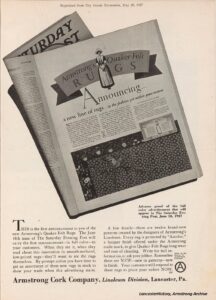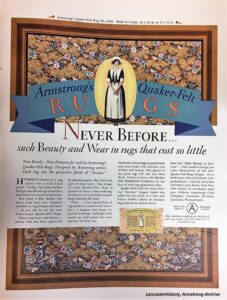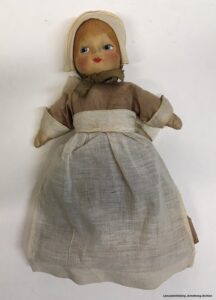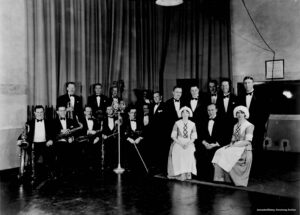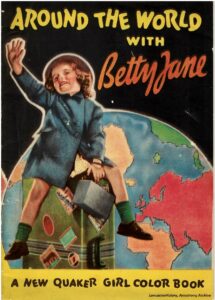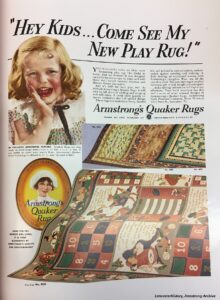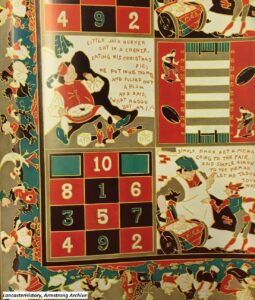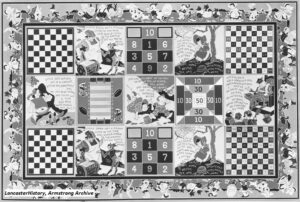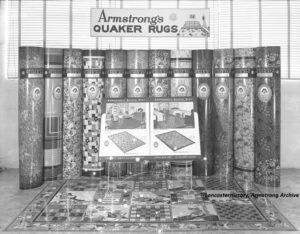Nursery Rhyme Time with Armstrong Quaker-Felt Rugs
Introducing Quaker-Felt Rugs and Floor Coverings
Armstrong Cork Company began to produce linoleum flooring in Lancaster in 1908 as a way to use excess cork produced by cutting round corks from rectangular slabs of corkwood. The ingredients of linoleum—oxidized linseed oil, cork dust, and organic resins—were combined to form a uniform layer attached to a woven burlap backing. In 1925, Armstrong introduced felt-base flooring as a more affordable alternative to printed linoleum. Similar in appearance to linoleum, felt-base took its name from its core, rag felt saturated with asphalt. In 1927, Armstrong introduced a new lacquer finish they called Accolac that improved wear, provided an attractive sheen, and better protected the face against damage. The Armstrong Line flooring pattern book for 1927 advised the retailer that felt-base Quaker Rugs “should help retailers to meet the needs of that class of trade that cannot afford to buy genuine linoleum” while at the same time assuring the retailer that these same flooring materials “are made of heavy roofing felt, saturated with asphalt, with a design printed on the surface and a waterproof coating on the back” and “are, in their class, as markedly superior as to design and quality as are Armstrong Linoleum Rugs.”
Marketing Quaker-Felt Rugs and Floor Coverings
To help sell the new product to consumers, Armstrong called its new felt-base product Quaker Rugs in an effort to associate the product with Pennsylvania and the perceived Quaker values of thrift, simplicity, and cleanliness. To help promote the sales of Quaker Rugs, Armstrong chose the Quaker Girl as the personification of those values. Armstrong featured the Quaker Girl in various newspaper and magazine advertisements as well as in various promotions designed to appeal to children and homemakers. A comprehensive radio marketing and advertising plan introduced the Quaker Girl and the Armstrong Quakers, a vocal group backed by a full orchestra, to a live audience. Various radio programs sponsored by Armstrong between 1928 and 1954 featured introductions and commercials by the Quaker Girl highlighting different Quaker Rug patterns and using descriptive language to help the listener visualize the panoply of available colors and patterns.
Nursery Rhyme Time!
Armstrong introduced Play Rug pattern 4595 in 1936. The Armstrong Line flooring pattern book for 1937 described Armstrong’s Quaker Rugs as “bright, colorful, long-wearing, and easy to clean. These rugs are made with the same care and skill that go into the manufacture of Armstrong’s Linoleum. They are beautifully printed in rich oil colors on good thick felt.” The pattern book further describes Play Rug 4595 as “the most novel ever offered in the Quaker Rug Line. It combines the utility of a good floor covering with an entertainment feature for children. Nursery rhymes and ‘boards’ give it an appeal not to be had in other rugs.” The pattern could be had in various sizes designed to accommodate almost any room. Armstrong designed the Play Rug so children could amuse themselves all day long looking at Mother Goose characters, repeating familiar nursey rhymes, or playing various games.
By 1957, Armstrong had replaced its earlier Quaker Play Rug pattern 4595 with pattern 4500 Story-book, a similar but distinct pattern featuring Mother Goose as well as other familiar childhood and nursery rhyme characters. By the mid-1960s, advances in technology and changing consumer tastes, including a growing preference for tufted and woven carpet, meant that Quaker printed felt-base flooring ceased to be produced.
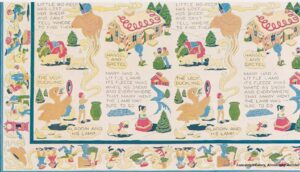
From Archives Blog

